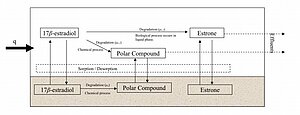Fate and Transport of Endocrine Disrupting Chemicals in Soil-Water Systems
Goal #4: Develop, apply, and evaluate a model that can be used to identify and predict fate and transport of various estrogen.
Objectives
- Develop a hypothesis of the fate and transport of 17b-estradiol and its metabolites based upon experimental results. Incorporate this hypothesis into a computer model.
- Apply the model using inverse modeling methods.
- Evaluate the model for its ability to predict experimental data, and reevaluate the model according to this prediction.
Advancements in inverse modelling procedures have been made in this research, which have helped to improve and identify the fate and transport processes of labile chemicals involved in chain reactions.
The water transfer - solute transport model, Hydrus1D, was modified to include transport of labile hormones.

Model Schematic
Schematic of the fate and transport of 17b-estradiol in a soil water system. Hydrus1D was modified to include this complex transformation process, which helped to identify parameters that capture the fate and transport rates of hormones in soil.